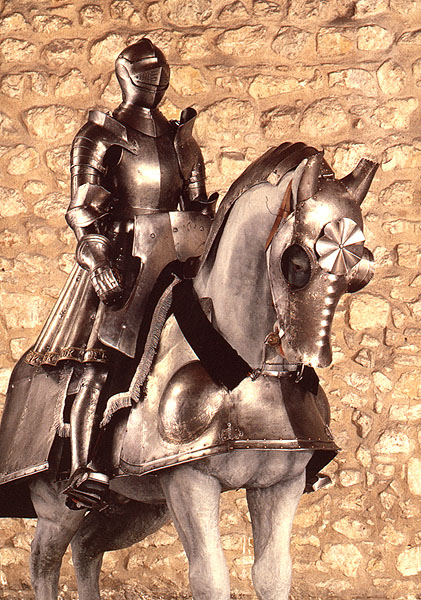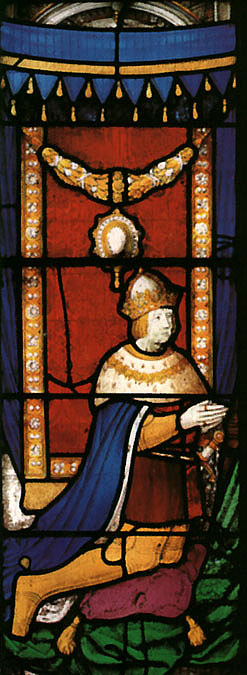
Armor of Henry VIII from about 1515 (taken from http://tudorhistory.org/henry8/gallery2.html) Henry Tudor, named after his father, Henry VII, was born in 1491. Since he was the second son, and not expected to become king, we know little of his childhood until the death of his older brother Arthur, Prince of Wales. We know that Henry attended the wedding celebrations of Arthur and his bride, Catherine of Aragon, in 1501 when he was 10 years old. But, four months after the marriage began, it ended, with Arthur's death. A treaty was signed that would allow Catherine to marry the next heir to the throne -- Prince Henry. Until then, Catherine's parents would send over 100,000 crowns worth of plate and gold as a wedding gift and Henry would pay the agreed upon dowry. It was deemed necessary for a papal dispensation to be issued allowing Henry to marry Catherine, as she was his dead brother's wife, and this marriage was prohibited in the Bible. Catherine denied that her marriage to Arthur had even been consummated, so no dispensation was needed. However, both the parties in Spain and England wanted to be sure of the legitimacy of the marriage, so permission from the pope was sought and received. The marriage still did not take place however. Henry VII had been slow to pay his part of the arrangement and her parents were refusing to send the marriage portion of plate and gold. The stalemate continued until Henry VII died on April 22, 1509 and his son became Henry VIII. Henry was just shy of 18 years old when he became king, and had been preparing for it from the time of his older brother Arthur's death. (abridged from http://tudorhistory.org/henry8/)  A portrait of Henry by Hans Holbein the Younger (1497-1543) made c. 1536. Oil on panel, 28x20 cm (taken from http://tudorhistory.org/henry8/gallery.html)  A stained glass portrait of Henry (taken from http://tudorhistory.org/henry8/gallery.html) 
Catherine of Aragon was the child of Ferdinand and Isabella of Spain. As was common for princesses of the day, her parents almost looked for a political match for her. When she was three year old, she was betrothed to Arthur, the son of Henry VII of England. Arthur was not even quite two at the time. When she was almost 16, in 1501, Catherine made the journey to England and was married to Arthur. Less than six months after the wedding, Arthur was dead. Henry VII still had a son. The English king was interested in keeping Catherine's dowry, so 14 months after her husband's death, she was betrothed to the future Henry VIII, who was too young to marry at the time. When Henry VII died in 1509, Henry VIII married Catherine and she was crowned Queen of England. Catherine's first child was a stillborn daughter born prematurely in January 1510. Soon Prince Henry was born in 1511 but the baby died after 52 days. Catherine then had a miscarriage, followed by a short-lived son. On February 1516, she gave birth a daughter named Mary, and this child lived. Henry was growing frustrated by his lack of a male heir. By 1526, he had begun to separate from Catherine because he had fallen in love with the sister of his mistresses: Anne Boleyn. Catherine was then 42 years old and was no longer able to conceive. Henry's main goal now was to get a male heir.The King began to petition the Pope for an annulment. When the news got to Catherine,she appealed directly to the Pope, which she felt would listen to her case since her nephew was Charles V, the Holy Roman Emperor. In 1533 when Anne Boleyn became pregnant. Henry had to act, and his solution was to reject the power of the Pope in England and to have Thomas Cranmer, the archbishop of Canterbury grant the annulment. Catherine was to renounce the title of Queen and would be known as the Princess Dowager of Wales. Three years later,Catherine died and was buried with the ceremony due for the position as Princess Dowager, not as a Queen of England. (abridged from http://tudorhistory.org/aragon/) Anne spent part of her childhood at the court of an archduchess at the age of about 12-13. Anne's sister Mary was already in 'the French Queen's' attendance. When Mary Boleyn returned to England, Anne remained in France to attend the new French queen. Anne remained in France for the next 6 or 7 years. She was considered moderately pretty, had dark, olive-colored skin, thick dark brown hair and dark brown eyes. Anne returned to England around 1521 to attend Queen Catherine. It is not known when and where Henry VIII first noticed Anne. Henry sought to make Anne his mistress, as he had her sister Mary years before. But eventually it evolved into "Queen or nothing" for Anne. King Henry's passion for Anne can be attested to in the love letters he wrote to her when she was away from court. Henry hated writing letters, and very few documents in his own hand survive. However, 17 love letters to Anne remain and are preserved in the Vatican library. Sometime near the end of 1532, Anne finally gave way and by December she was pregnant. Henry was forced into action. Sometime near January 25 1533, Anne and Henry were secretly married. Although the King's marriage to Catherine was not dissolved, in the King's mind it had never existed in the first place, so he was free to marry whomever he wanted. On May 23, the Archbishop officially proclaimed that the marriage of Henry and Catherine was invalid. On the 1st of June she became a crowned and anointed Queen in a ceremony led by Thomas Cranmer, the Archbishop of Canterbury. on September 7, 1533, the Princess Elizabeth was born. Her christening service was scaled down, but still a pleasant affair. Anne now knew that it was imperative that she produce a son. By January of 1534, she was pregnant again, but the child was either miscarried or stillborn. In 1535, she was become pregnant again but miscarried by the end of January. The child was reported to have been a boy. The Queen was quite upset, and blamed the miscarriage on her state of mind after hearing that Henry had taken a fall in jousting. She had to have known at this point that her failure to produce a living male heir was a threat to her own life, especially since the King's fancy for one of her ladies-in-waiting, Jane Seymour, began to grow. Anne's enemies at court began to plot against her using the King's attentions to Jane Seymour as the catalyst for action. Cromwell began to move in action to bring down the Queen. He persuaded the King to sign a document calling for an investigation that would possibly result in charges of treason. On May 2, 1536, the Queen was arrested for the charges of adultery, incest and plotting to murder the King. On Monday the 15th, the Queen and her brother were put on trial and found guilty. They were to be either burnt at the stake or beheaded, at the discretion of the King. On the morning of May 19, 1536, Anne was to be afforded the dignity of a private execution. (abridged from http://tudorhistory.org/boleyn/) 
Allegorical painting of Henry VIII passing the throne to Edward VI (taken from http://tudorhistory.org/henry8/gallery.html) |